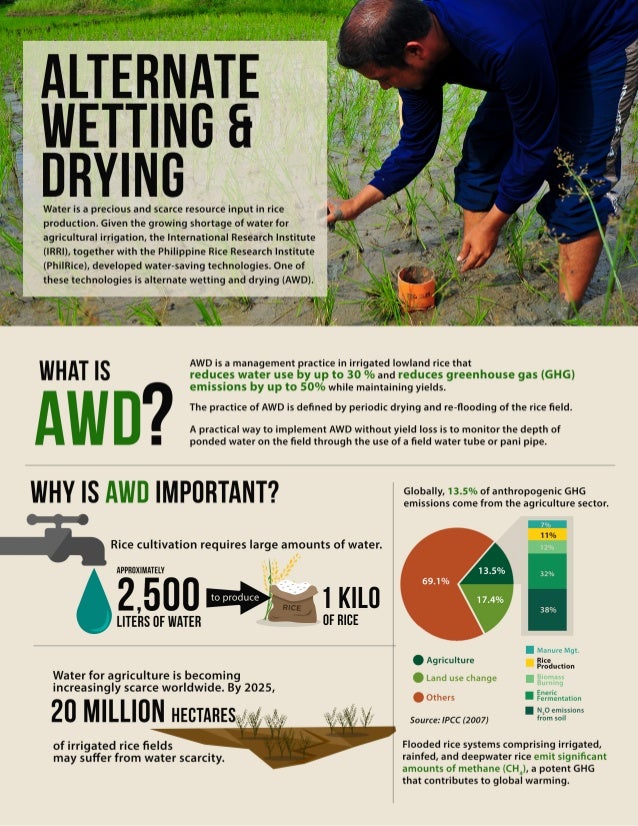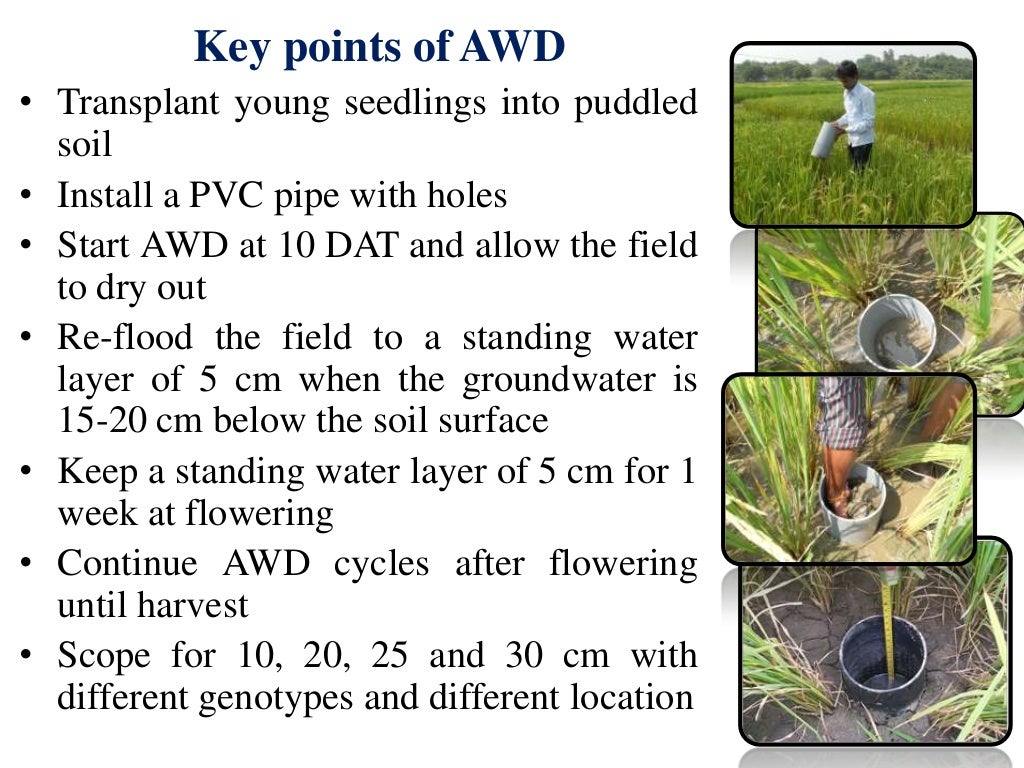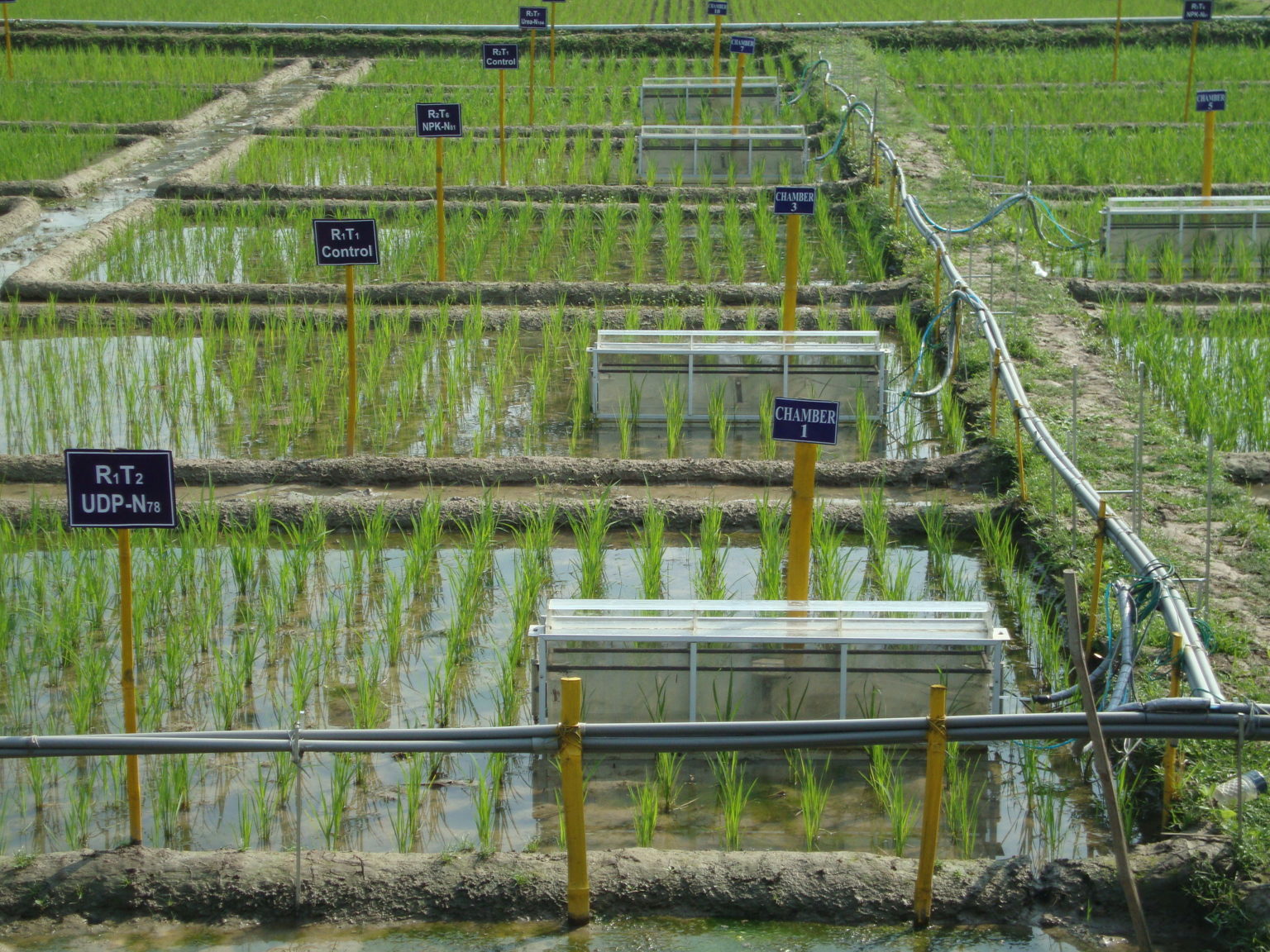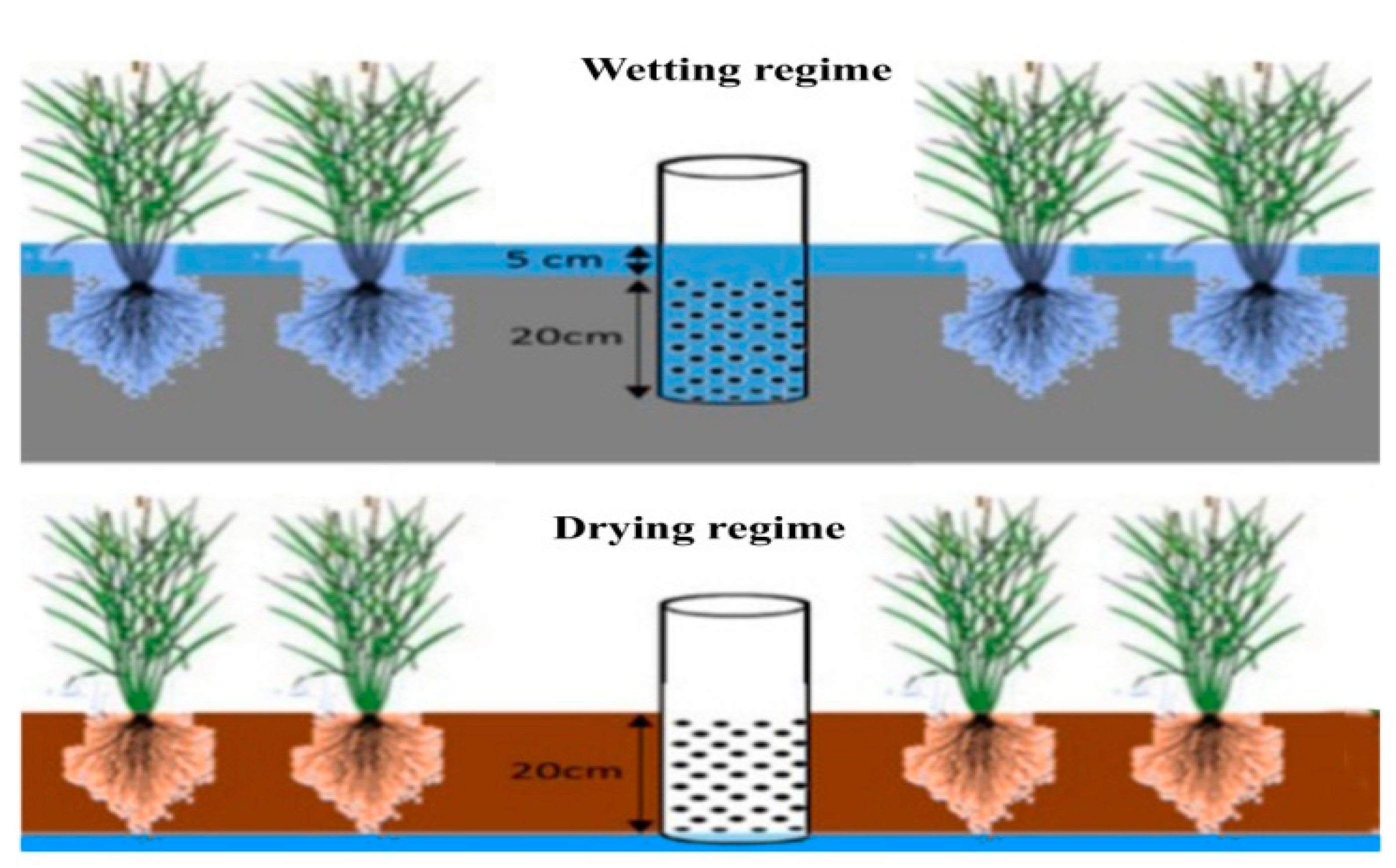
ClimateSmart Land Use Insight Brief No. 2 Alternate wetting and drying for climate change
Alternate wetting and drying (AWD) is widely regarded as a water-saving irrigation technology capable of contributing to sustainable water-use. Existing literature lacks rigorous quantitative analysis of the determinants and effects of AWD adoption. In contrast, applying logit, propensity score matching and multiple regression models.

alternate wetting and drying The Rice Stuff
Alternate wetting and drying ( AWD) is a water management technique, practiced to cultivate irrigated lowland rice with much less water than the usual system of maintaining continuous standing water in the crop field. It is a method of controlled and intermittent irrigation.

(PDF) Alternate wetting and drying in irrigated rice Implementation guidance for policymakers
Alternate Wetting and Drying (AWD) is a well-known low-cost water-saving and climate change adaptation and mitigation technique for irrigated rice. However, its adoption rate has been low despite the decade of dissemination in Asia, especially in the Philippines. Using cross-sectional farm-level survey data, this study empirically explored factors shaping AWD adoption in a gravity surface.

Alternate Wetting and Drying (AWD) Climate Smart Agriculture
Alternate wetting and drying (AWD) is a water-saving and eco-friendly option. • AWD requires 25-70 % less water than conventional system without yield reduction. • AWD reduces GHGs emission and restrict As and Hg accumulation in rice grains. Abstract

Alternate Wetting and drying irrigation (AWD) showing (a)Breakthrough... Download Scientific
The conventional practice of alternate wetting and drying (AWD) irrigation technique that typically starts at 21 days after transplanting (DAT) can hardly reduce this emission because the soil become methanogenic before the onset of AWD treatment.

Infographic Alternate wetting and drying in irrigated rice
Alternate wetting and drying (AWD) irrigation is panacea for water scarcity glitches (Pourgholam-Amiji et al., 2020). Keywords: Frequent, harmful, highest, insect pest infestation,.

Training on Alternate Wetting and Drying (awd) in rice
Alternate wetting and drying (AWD) has been recognized as a water-saving technology in rice production systems; however, pre- and post-flowering AWD could induce changes in yield, quality and aroma biosynthesis in fragrant rice. In the present study, two fragrant rice cultivars (Guixiangzhan and Nongxiang-18) were subjected to AWD.

usdagov 19587335711 Poly pipe and alternate wetting and drying Stock Photo Alamy
Alternate wetting and drying (AWD) is a simple and inexpensive way of reducing water consumption in rice production by 30%, thus, enabling farmers to cut down on production cost without yield penalty. AWD entails periodic draining of the field to a certain threshold, usually 15 cm below the soil surface, and re-flooding..

Alternate wetting and drying before and after 25 and 50 cycles. Download Scientific Diagram
Alternate Wetting and Drying (AWD) is a water-saving technology that farmers can apply to reduce their irrigation water consumption in rice fields without decreasing its yield. In AWD, irrigation water is applied a few days after the disappearance of the ponded water. Hence, the field gets alternately flooded and non-flooded.

The Alternate Wetting And Drying Water Management In Rice Field (AWD) YouTube
The alternate wetting and drying (AWD) as water-saving technology aligns with the good agricultural practices (GAP) principles, particularly in the environmental management of water conservation. Thus, GAP adopters as farmer groups are seen as viable AWD adopters in the initial stages of scaling out the adoption in Thailand. However, the understanding of integrating AWD as water-saving.

Alternate Wetting and Drying Isbell Farms
CH4 emissions were observed under alternate wetting and drying than continuous flood-ing [20,21]. Islam et al. [20] conclude that GHG emission-reducing technology (e.g., urea deep placement or UDP) combined with a water-saving management strategy like AWD compared to rice production under continuous flooding conditions is effective.

Alternate Wetting and Drying (AWD) Irrigation YouTube
Alternate wetting and drying (AWD) is a simple and inexpensive way of reducing water consumption in rice production by 30%, thus, enabling farmers to cut down on production costs without yield penalty. AWD entails periodic draining of the field to a certain threshold, usually 15 cm below the soil surface, and re-flooding.

Mitigating GHG Emissions from Rice Fields through Alternate Wetting and Drying Irrigation IFDC
Alternate wetting and drying (AWD) is a water-saving irrigation technique in a paddy field that can reduce the emission of methane, a potent greenhouse gas (GHG). It is being adopted to Asian countries, but different results are reported in literatures on methane, nitrous oxide emission, and rice productivity under AWD..

(PDF) Alternate Wetting and Drying (AWD) irrigation A smart water saving technology for rice
Alternate wetting and drying ( AWD) is now accepted as a viable mitigation measure in agriculture. Through this technique, rice farmers can reduce methane emissions, cut their pumping costs and enhance the efficiency of their water use. AWD; however, offers a variety of adaptation options as well.

Agronomy Free FullText Impact of Organic Amendment with Alternate Wetting and Drying
Alternate wetting and drying (AWD) is the irrigation technique, in which a paddy field encompasses several soil-drying phases during the growth period, thereby reducing the CH 4 emission. However, field trials of the AWD's feasibility in Central Vietnam are limited so far. We therefore carried out a 3-year experiment in a farmer.

How to Make Alternate Wetting and Drying YouTube
Sustainable Development Goals Climate action and life on land Alternate wetting and drying (AWD) is a water-saving technology that lowland (paddy) rice farmers can apply to reduce their water use in irrigated fields. In AWD, irrigation water is applied to flood the field a certain number of days after the disappearance of ponded water.